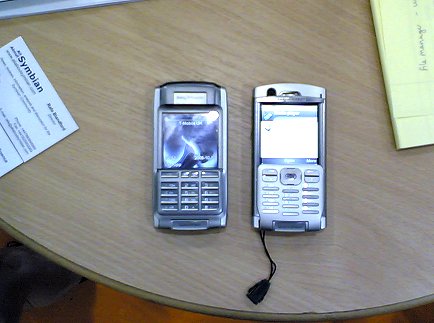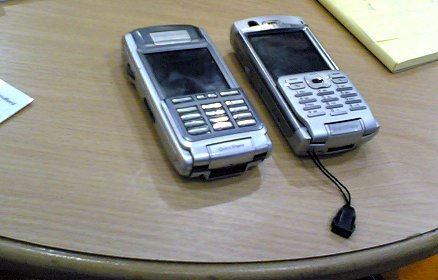Staying with 990 though does seem to back up the fact that this unit is solidly part of the P900 lineage. It’s as close as you can get to a new model without actually hitting the P1000 range of numbers. It’s obviously an evolution, and if you’ve been paying attention, there are really no shocks in the hardware or the specification.
What Can You See
[The pictures on the right show the P990 next to a standard P910i - apologies for the fingerprints all over both, but the P990 in particular had seen 1000s of grubby fingers handle it over the previous four hours!]
 Let’s start with the screen. Although physically it’s only a few millimetres away from the tradition 208x320 screens of previous P devices, the pixel dimensions are a standard QVGA 240x320. Stylus control is accurate, even with the increased density of pixels. The extra size is going to allow more information and clearer status bars during use, but it’s not noticeable during use that the extra pixels are cramming in more information – everything is clear and laid out sensibly as before. Of course a lot of that is in the UIQ interface and screen handling. Closing the flip actually changes the UI. Where before we had a hard coded ‘flip closed’ mode, flip closed in UIQ3 is just another UI layer. Because of this, every correctly programmed application will have a flip closed mode with minimal extra effort from the developers.
Let’s start with the screen. Although physically it’s only a few millimetres away from the tradition 208x320 screens of previous P devices, the pixel dimensions are a standard QVGA 240x320. Stylus control is accurate, even with the increased density of pixels. The extra size is going to allow more information and clearer status bars during use, but it’s not noticeable during use that the extra pixels are cramming in more information – everything is clear and laid out sensibly as before. Of course a lot of that is in the UIQ interface and screen handling. Closing the flip actually changes the UI. Where before we had a hard coded ‘flip closed’ mode, flip closed in UIQ3 is just another UI layer. Because of this, every correctly programmed application will have a flip closed mode with minimal extra effort from the developers.
Steve’s going to have a look at the main changes in UIQ 3 later this week – in short it’s moved forward quite a bit from UIQ 2.1 in the P910i, taking in a lot of user feedback.
Hardware Changes
Not everything has moved forward, though. The number pad flip has moved back to the style of the P900. The P910i had a number of complaints that it was impossible to touch type a phone number or an SMS because of the flat keypad. With the bars returning, function has prevailed over form. It’s nice to see Sony Ericsson doing this, and the respect for the end user is clear.
This respect is something that I really appreciated. Staying with the flip, you can choose to run your phone with the flip, or remove it for a device that looks suspiciously close to a Treo. I’m a big fan of ‘flipping off’ with the P900 and P910i, so the addition of a sliding switch on the left hand edge of the case to activate the screen lock is another welcome tweak to the UI. On the other hand, I know Rafe is much more in favour of using the flip on the P990, as with all the P models.
Physically, the device is only a millimetre or two larger than the P910i, but there is no two-tone colour effect, so it looks like it should be a lot larger. One missing feature is in the jog dial. Rest assured the jog dial is still there, but it no longer has the ‘pull forward, push back’ function. It looks like the power users were familiar with this function, but the average user never knew it existed, or kept hitting it by mistake and wondering what was going on.
What’s New In The Software?
 Connectivity-wise, the P990 will connect to your PC with USB, and any Memory Stick will show up as a mass storage device (but not the internal drive). Wi-Fi and 3G are available to get an Internet/data connection, and the GPRS/GSM frequencies are the standard triband of 900/1800 and 1900. A lot of people (including Steve and myself) are happy to see that the infrared port has been retained.
Connectivity-wise, the P990 will connect to your PC with USB, and any Memory Stick will show up as a mass storage device (but not the internal drive). Wi-Fi and 3G are available to get an Internet/data connection, and the GPRS/GSM frequencies are the standard triband of 900/1800 and 1900. A lot of people (including Steve and myself) are happy to see that the infrared port has been retained.Probably the biggest change is the camera. It’s a full 2 megapixel camera, and it’s incredibly easy to use for two reasons. The first is that switching to the camera is a simple matter of opening the lens cover. At that point you can forget about UIQ as the interface, because you’ll get a full screen viewfinder powered by a display that’s eerily similar to the Sony Cybershot digital camera ranges – a UI that’s already been proven in the field. As well as still pictures at 2 megapixel, you also have video recording at QVGA (320 by 240) resolution.
The other major addition is going to be in music. While the P range devices have always carried the ability to do MP3, the P990 is going to be the most comprehensive music player yet. While not taking the Walkman brand, the SE developed software for that product should be available (in some form) for the P990. One step backwards is lack of support for a standard 2.5mm smartphone stereo headset. Instead, you have to use the supplied Sony Ericsson headset that plugs into the multi-connector on the bottom of the device.
Closing Thoughts
The P990 is obviously going to be the flagship Sony Ericsson smartphone, and for the Symbian OS fans who have come from a PDA background, it fulfils the promise of a world-class PDA in the phone form. The P900 and P910i were almost there, and the P990 has made the final step. With the built-in software for the UIQ platform, plus additions such as Quickoffice and Opera 8, Sony Ericsson look to have a winning device that pushes back a number of barriers, while keeping everything accessible for the end-user. There’s still a lot of (software) work to be done on the device, but when it arrives next year it’s should be very, very high up on the wanted list of smartphone users everywhere.
